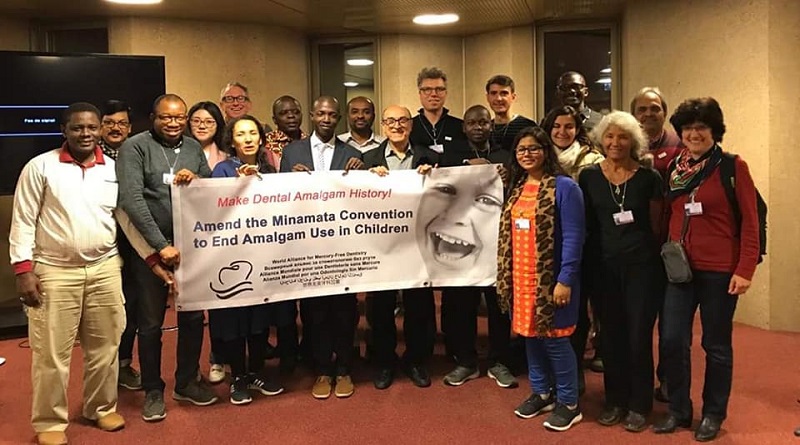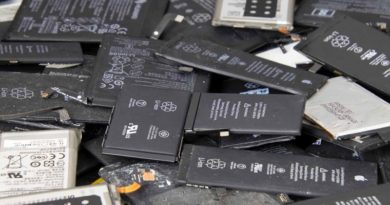Mercury: Activists urge countries to end amalgam use in children by 2020
Picture Caption: Members of the World Alliance for Mercury-Free Dentistry in a group photography in after a pre-COP meeting Geneva, Switzerland at the weekend.
As the week long second meeting of the Conference of the Parties to the Minamata Convention on Mercury (COP 2) kicks off in Geneva, Switzerland on Monday November 19 to 23, 2018, activists under the aegis of World Alliance for Mercury-Free Dentistry have called on countries to end amalgam use in children by 2020.
According to them, children are particularly vulnerable to mercury: Children’s developing brains and neurological systems are especially susceptible to neuro toxic effects of mercury, and that as the Minamata Convention says, Parties are “Aware of the health concerns, especially in developing countries, resulting from exposure to mercury of vulnerable populations, especially women, children, and, through them, future generations.”
The group, in a statement issued in Geneva, Switzerland on Sunday November 18, 2018 after its pre-COP2 meeting and made available to Ecogreen News stressed that Mercury-free alternatives are available for children’s teeth: Mercury-free fillings are available for children. As the World Health Organization report Future Use of Materials for Dental Restoration explains, “Alternative restorative materials of sufficient quality are available for use in the deciduous [milk] dentition of children.” Between the irrelevancy of filling longevity in short-lived milk teeth and amalgam’s higher failure rates in these teeth, using amalgam instead of mercury-free fillings in children can longer be justified.
The World Alliance for Mercury-Free Dentistry explained that ending amalgam use in children is a proven phase down step: The Minamata Convention requires each Party to “phase down the use of dental amalgam.” Ending or restricting amalgam use in children has already proven to be an effective phase down step: Norway and Sweden started by recommending against amalgam use for vulnerable populations, such as children and pregnant women. Now both countries have phased out amalgam use. Denmark restricted amalgam use in children in 2003. Now dental amalgam is used for only 5% of restorations. The Netherlands discouraged amalgam use in children. Now dental amalgam is used for only 1% of restorations. Finland issued national guidelines recommending that amalgam should not be used in children and pregnant women. Now dental amalgam is used for only 3% of restorations.
“For these reasons, UN Environment and the World Alliance co-sponsored a workshop on Promoting Dental Amalgam Phase-Down Measures Under the Minamata Convention and Other Initiatives, For “Especially Women, Children and, Through Them, Future Generations” in Bangkok on 14-15 May 2018. Experts hailing from twenty-one countries shared their wealth of experience in phasing down amalgam use – especially for children – in a variety of settings. For example, as detailed in the workshop report, 17 participants explained how:”
“In South Asia, both the Bangladeshi Armed Forces and the Indian Armed Forces provide only mercury-free fillings for their soldiers, sailors, and airmen – and their families. In Central Africa, the Cameroun Baptist Convention ended amalgam use in its large hospital system and dental clinics that dot the nation more than a decade ago. In West Africa, the Nigerian federal Consumer Protection Council distributes a brochure urging parents and consumers to consider mercury-free fillings for themselves and their children. In South America, Uruguay’s dental college has phased out teaching amalgam and started preparing all of its students for modern mercury-free dentistry. In both the large European Union and the tiny island nation of Mauritius, amalgam use for children has been effectively ended.
“The beginning of the end is already here for amalgam use in this most vulnerable population. It’s time to
“The beginning of the end is already here for amalgam use in this most vulnerable population. It’s time to stop storing mercury in children’s mouths – and put it where it belongs: the hazardous waste bins of history.
“Let’s Make Dental Amalgam History: End Amalgam Use in Children by 2020.
Executive Director, Sustainable Research and Action for Development (SRADev Nigeria) Dr. Leslie Adogame, explained that Nigeria’s process to actualise this started in 2014 with the famous – Abuja Declaration.
He went further, “Recently a national stakeholder’s summit organized by Federal Ministry of Health in collaboration with SRADev Nigeria on Development of National Policy on Phase Down of Dental Amalgam use held at Barcelona Hotel, Abuja on 17 July 2018, resolved “To end the use of Dental Amalgam as restorative material in children under 16 years, pregnant women and breastfeeding mothers (the vulnerable group) by December 2020, and finally make amalgam use history by setting Amalgam phase out date in Nigeria for December 2022.”
Mercury is used in dental amalgam, a restorative material that is approximately 50% mercury. Between 270 and 341 tonnes of dental mercury is used around the world annually, accounting for 21% of global mercury consumption. Dental mercury enters the environment via many unsound pathways, polluting (1) air via cremation, dental clinic emissions, and sludge incineration; (2) water via dental clinic releases and human waste; and (3) soil via landfills, burials, and fertilizer. As a result, many children around the world are exposed to a double dose of amalgam’s mercury: first when it is implanted in their teeth and a second time when it contaminates their environment.
The World Alliance for Mercury-Free Dentistry is a global coalition of NGOs that brings together dentists, scientists, physicians, journalists, environmentalists, patients, parents, consumers, engineers, academics, and other civil society stakeholders to work for the end of dental amalgam – especially for children.




